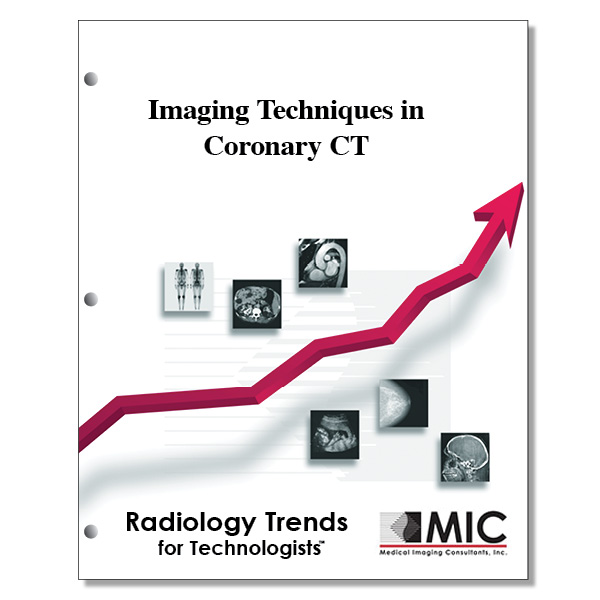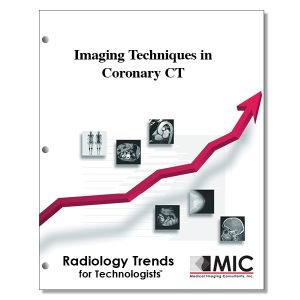

Imaging Techniques in Coronary CT
A discussion of the limitations of standard coronary CT and a look at current imaging techniques to overcome these limitations.
Course ID: Q00465 Category: Radiology Trends for Technologists Modalities: Cardiac Interventional, CT2.5 |
Satisfaction Guarantee |
$29.00
- Targeted CE
- Outline
- Objectives
Targeted CE per ARRT’s Discipline, Category, and Subcategory classification for enrollments starting after January 28, 2025:
Computed Tomography: 2.50
Safety: 0.25
Radiation Safety and Dose: 0.25
Image Production: 1.25
Image Formation: 1.00
Image Evaluation and Archiving: 0.25
Procedures: 1.00
Neck and Chest: 1.00
Outline
- Introduction
- Standard Coronay CT and Its Limitations
- Standard Retrospective ECG-gated Helical Scan
- Radiation Exposure and Cancer Risk
- Retrospective ECG-gated Helical Scan with ECG-controlled Tube Current Modulation
- Low-tube Voltage Scan
- Limitations of Standard Coronary CT
- Insufficient Spatial Resolution
- Bean-hardening Artifacts
- Insufficient Temporal Resolution
- Stair-step Artifacts
- No functional Assessment
- Current and Novel Imaging Techniques of Coronary CT
- Prospective ECG-gated Axial Scan (Step-and-Shoot Scan
- Iterative Reconstruction
- High-Definition CT
- Dual-Source CT
- Prospective ECG-gated High-Pitch Dual-Source Helical Scan
- Motion Correction Algorithm
- Intelligent Boundary Registration
- Dual-Energy CT
- Dual-Source CT Scanner
- Single-Source CT Scanner with Fast Switching of Tube Voltage
- Bean-hardening Correction
- Monochromatic Images
- Material Density Images
- Coronary Plaque Component Analysis
- Myocardial Perfusion Imaging
- FFR Derived from CT
- Summary
Objectives
Upon completion of this course, students will:
- be familiar with the patient population that will benefit from coronary CT
- identify the limitations in the usefulness of coronary CT
- identify the imaging solutions to reduce radiation dose in coronary CT
- be familiar with the capabilities enabled by ECG recording in coronary CT
- identify the imaging solution for decreasing beam hardening in coronary CT
- identify the imaging solution for improving spatial resolution in coronary CT
- identify the imaging solution for increasing contrast enhancement in coronary CT
- be familiar with the expression for radiation dose in coronary CT
- be familiar with the use of dose length product in coronary CT
- be familiar with the radiation dose associated with retrospective ECG-gated helical scanning
- recognize the patient populations at greater cancer risk from the radiation dose in coronary CT
- understand the relationship of radiation dose to tube voltage
- understand the relationship of voltage to iodinated contrast attenuation
- be familiar with the artifact resulting from partial volume effect
- understand the artifacts related to insufficient temporal resolution
- be familiar with the primary cause of stair-step artifacts in coronary CT
- be familiar with the methods of radiation reduction using the step-and-shoot axial scanning technique
- identify the advantages of using iterative reconstruction algorithms in coronary CT
- identify the disadvantages of using iterative reconstruction algorithms in coronary CT
- be familiar with iterative reconstruction algorithms in coronary CT
- be familiar with the reduction in radiation dose using adaptive statistical iterative reconstruction
- be familiar with the improved contrast resolution in high-definition CT
- be familiar with the angle of the x-ray tubes in dual-source CT
- understand the effects of dual-source CT on temporal resolution
- be familiar with the discontinued use of beta blockers due to the use of dual-source CT in coronary CT
- understand the significant reduction in radiation dose associated with using ECG-gated high-pitch dual-source helical CT
- be familiar with the heart rate limitations for using ECG-gated high-pitch dual-source helical CT
- be familiar with the advantages of using motion correction in coronary CT
- be familiar with the advantages of using intelligent boundary registration in coronary CT
- be familiar with the advantages of using single-source dual-energy CT with fast switching tube voltage in coronary CT
- be familiar with the advantages of using material density images in coronary CT
- be familiar with the use of color-coded iodine maps for detection of myocardial perfusion defects
- be familiar with the use of FFR
- be able to identify the current and novel imaging solutions not used in coronary CT
- be able to identify the current and novel imaging solutions used in coronary CT
